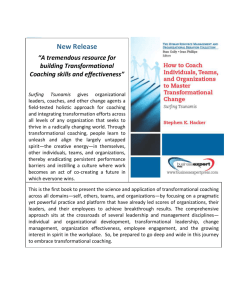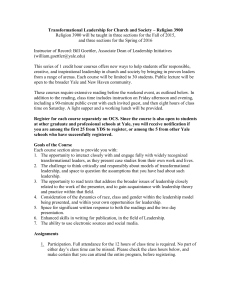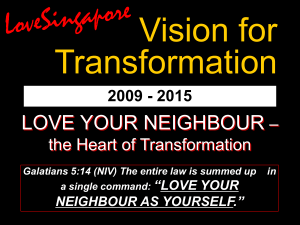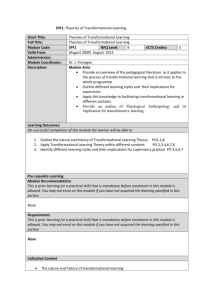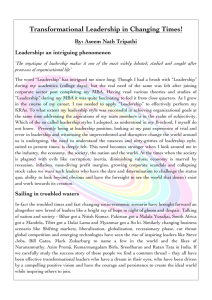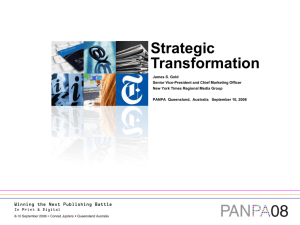ISE6701 - Department of Industrial and Systems Engineering
advertisement
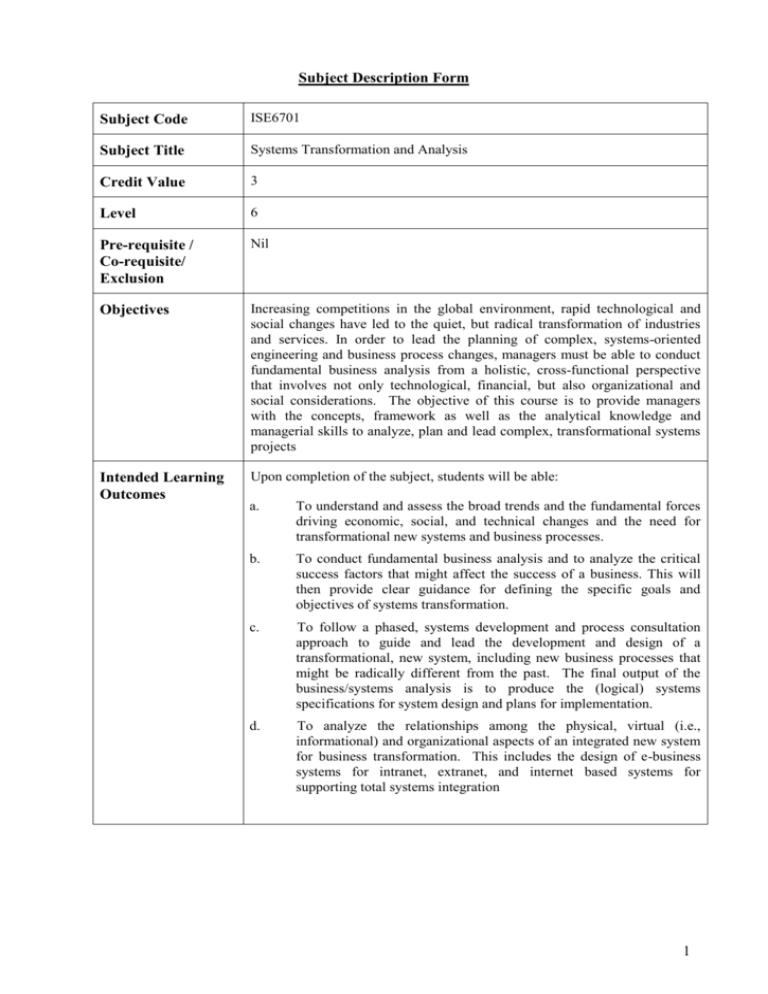
Subject Description Form Subject Code ISE6701 Subject Title Systems Transformation and Analysis Credit Value 3 Level 6 Pre-requisite / Co-requisite/ Exclusion Nil Objectives Increasing competitions in the global environment, rapid technological and social changes have led to the quiet, but radical transformation of industries and services. In order to lead the planning of complex, systems-oriented engineering and business process changes, managers must be able to conduct fundamental business analysis from a holistic, cross-functional perspective that involves not only technological, financial, but also organizational and social considerations. The objective of this course is to provide managers with the concepts, framework as well as the analytical knowledge and managerial skills to analyze, plan and lead complex, transformational systems projects Intended Learning Outcomes Upon completion of the subject, students will be able: a. To understand and assess the broad trends and the fundamental forces driving economic, social, and technical changes and the need for transformational new systems and business processes. b. To conduct fundamental business analysis and to analyze the critical success factors that might affect the success of a business. This will then provide clear guidance for defining the specific goals and objectives of systems transformation. c. To follow a phased, systems development and process consultation approach to guide and lead the development and design of a transformational, new system, including new business processes that might be radically different from the past. The final output of the business/systems analysis is to produce the (logical) systems specifications for system design and plans for implementation. d. To analyze the relationships among the physical, virtual (i.e., informational) and organizational aspects of an integrated new system for business transformation. This includes the design of e-business systems for intranet, extranet, and internet based systems for supporting total systems integration 1 Subject Synopsis/ Indicative Syllabus 1. Trends and factors driving business and systems analysis and organizational transformation; Examples of transformational systems Overview of four broad trends that are driving economic, social and technological changes globally, and analysis of specific factors driving business changes in China/Hong Kong. today. Examples of transformational, systems-based new businesses in the west, and examples of transformational systems projects in Hong Kong and China. 2. Complexities and challenges of designing, developing and managing a transformational business system. Why so many new systems are doomed to commit major, costly errors from the start? Why do so many computer information systems fail? Why are integrated systems so difficult to implement? Differences in approaches between the planning and implementation of large scale systems in organization. Why are transformational systems difficult to develop? What are the common factors that have limited the success of process re-engineering efforts? How should we think about transformational systems? 3. Conducting fundamental business analysis. The starting point for analyzing the goals and objectives of a transformational system is to examine the “fundamental nature of its business”; i.e. don’t be limited right way by just the technical or financial considerations. What is a “business”? Why is the traditional industry analysis or SWOT analysis inadequate? How to zero in on the “critical success factors“ of a business? Case studies to illustrate how successful businesses have transformed and dominated their competitors, and the central role of their back-end, transformational systems. 4. Role of the project leader in a transformational, systems project and management approach How to follow a phased, structured, systems development process to guide and lead the analysis. The input, output for each phase, as well as the required activities for each phase. How does a system analyst create value for the organization? How to prepare a high quality analysis report or presentation? 5. Concepts, methodologies and tools for systems modeling Differences between a logical design and a physical design for a system. Data flow modeling and structured analysis techniques: concepts and applications. The importance of a database management systems and data modeling as foundations to building information systems. 6. Virtual aspects of a business system: How to set up an effective ebusiness support platform for a transformational system How to analyze the virtual aspects of a business? What are the design shortcomings with most e-business systems? How to analyze ebusiness and build an effective e-business platform based on relationship analysis? How to apply the framework to build effective intranets and extranets for enterprise integration and interorganization systems? 2 Teaching/Learning Methodology and Course Materials: A mixture of lectures, illustrative examples, exercises, and case studies, will be used to deliver the fundamental concepts and to illustrate applications in this subject. More importantly, emphasis will be placed on interactive class discussions to stimulate students’ own thinking about the issues and concepts involved. There is no single, required textbook. The teaching materials will be drawn from a number of sources. These include: 1. For theories and philosophies, we will rely on excerpts from the classical writings by authors such as the late computer science professor and renowned business consultant Michael Hammer on “process reengineering”; the recent Nobel laureate in economics, Paul Krugman, on international economics and the changing social and economic trends; and various management scientists such as Ackoff, Ansoff and Forrester on systems thinking. 2. For applications and examples of transformational systems, we can use well known case examples such as Dell Online, Fed Ex, Walmart or Zip Car from overseas, in addition to local examples in Hong Kong such as the development of the Octopus Card by MTR, and the development of the supermarket chain by Park & Shop. We will also use specific case examples to explore the analysis of specific large scale systems in China, such as a current proposal to adapt the Zip Car model for a network of electric cars to solve the traffic congestion and energy pollution problems in Shanghai. We will also supplement the standard business school case studies with articles from newspapers and magazines for class discussions on more recent developments in Hong Kong and China. These real-world cases will be used in class discussions and assignments to help students develop their knowledge and skills, identify issues and formulate problems in an integrative manner to tackle complex business and systems analysis problems within specific social settings. 3. For computer science based, systems analysis concepts, theories, and modeling techniques, we will draw upon excepts from the traditional systems analysis books as well as the classic monographs by such computer scientists as Gane & Sarson, and Demarco & Yourdon on structured analysis approaches and modeling techniques. To illustrate the application of these concepts and techniques, I will use examples and exercises that I and other colleagues have developed over the last several decades to help students learn how to apply them to model and analyze practical systems problems. Teaching/Learning Methodology Intended subject learning outcomes a 1. Lectures b 2. Tutorials/Case Studies c d 3 Assessment Methods in Alignment with Intended Learning Outcomes Student Study Effort Required Specific assessment methods/tasks % weighting Intended subject learning outcomes to be assessed a b c d 1. Individual papers 25 2. In-class written exercises 15 3. Individual Presentations Test 4. Take-Home Examination Paper 25 35 Total 100 Class contact: Lecture 27 Hrs. Seminar and case studies 12 Hrs. Other student study effort: Self study Total Student Study Effort Reading List and References 63 Hrs. 102 Hrs. To be delivered by the lecturer. 4


